BACK TO EXHIBITS
Quilts and Human Rights
This exhibit was installed in the Main Gallery of the Michigan State University Museum, January 15 - August 24, 2008.
Why this exhibition at the Michigan State University Museum?
This exhibition grew out of several long-standing research and educational activities at the Michigan State University Museum that have been focused on the documentation and analysis of traditional culture. The museum is particularly interested in documenting and sharing the stories and work of artists who, because of race, ethnicity, gender, economics, or politics, have not been widely studied or presented. Many museum projects focus on quiltmaking and on the ways in which traditional arts are used to convey information on social causes.
Some images, objects, and issues addressed in this exhibit are graphic and may be disturbing to younger visitors; special explanation may be advised.
About the Quilts and Human Rights exhibition…
This exhibition examines the ways in which textiles—especially quilts—have been made and used to demonstrate solidarity with movements dedicated to advancing international human rights, to mark important events related to human rights violations, to pay tribute to those individuals who have played roles in human rights activism, to provide vehicles for the expression of feelings and memories about human rights violations, and to engage individuals in actions that will solve human rights issues.
About Quilts and Human Rights…
Textiles have long been used, mainly by women, as a medium to express feelings, values, and experiences that reflect upon and motivate action related to issues and needs in contemporary society. Textile artists who use their skills to express issues related to human rights do so in many forms and for many purposes. In some cases, textiles have been produced by individual makers who, working alone, simply wish to make a statement; others have been produced by women working in organized efforts to subversively or overtly protest against human rights abuses or to record the histories and memories of individuals whose stories traditionally are overlooked and under-recorded.
What are the Universal Declaration of Human Rights and the International Bill of Human Rights?
When the world community became aware of the atrocities committed by Nazi Germany, the United Nations realized that it needed to define what human rights should be expected internationally. On December 10, 1948, the United Nations General Assembly in Paris adopted The Universal Declaration of Human Rights (UDHR). The UDHR consists of 30 articles that outline the human rights that should be guaranteed to all people. In 1966 the United Nations General Assembly adopted the two detailed Covenants that complete the International Bill of Human Rights; and in 1976, the Bill took on the force of international law. Today, the International Bill of Human Rights continues to have a profound influence on the thoughts and actions of individuals and their governments in all parts of the world.
The Universal Declaration of Human Rights
Now, Therefore THE GENERAL ASSEMBLY proclaims THIS UNIVERSAL DECLARATION OF HUMAN RIGHTS as a common standard of achievement for all peoples and all nations, to the end that every individual and every organ of society, keeping this Declaration constantly in mind, shall strive by teaching and education to promote respect for these rights and freedoms and by progressive measures, national and international, to secure their universal and effective recognition and observance, both among the peoples of Member States themselves and among the peoples of territories under their jurisdiction.
/Article 1./ All human beings are born free and equal in dignity and rights. They are endowed with reason and conscience and should act towards one another in a spirit of brotherhood.
/Article 2./ Everyone is entitled to all the rights and freedoms set forth in this Declaration, without distinction of any kind, such as race, color, sex, language, religion, political or other opinion, national or social origin, property, birth or other status. Furthermore, no distinction shall be made on the basis of the political, jurisdictional or international status of the country or territory to which a person belongs, whether it be independent, trust, non-self-governing or under any other limitation of sovereignty.
/Article 3./ Everyone has the right to life, liberty and security of person.
/Article 4./ No one shall be held in slavery or servitude; slavery and the slave trade shall be prohibited in all their forms.
/Article 5./ No one shall be subjected to torture or to cruel, inhuman or degrading treatment or punishment.
/Article 6./ Everyone has the right to recognition everywhere as a person before the law.
/Article 7./ All are equal before the law and are entitled without any discrimination to equal protection of the law. All are entitled to equal protection against any discrimination in violation of this Declaration and against any incitement to such discrimination.
/Article 8./ Everyone has the right to an effective remedy by the competent national tribunals for acts violating the fundamental rights granted him by the constitution or by law.
/Article 9./ No one shall be subjected to arbitrary arrest, detention or exile.
/Article 10./ Everyone is entitled in full equality to a fair and public hearing by an independent and impartial tribunal, in the determination of his rights and obligations and of any criminal charge against him.
/Article 11./ (1) Everyone charged with a penal offence has the right to be presumed innocent until proved guilty according to law in a public trial at which he has had all the guarantees necessary for his defense. (2) No one shall be held guilty of any penal offence on account of any act or omission which did not constitute a penal offence, under national or international law, at the time when it was committed. Nor shall a heavier penalty be imposed than the one that was applicable at the time the penal offence was committed.
/Article 12./ No one shall be subjected to arbitrary interference with his privacy, family, home or correspondence, nor to attacks upon his honor and reputation. Everyone has the right to the protection of the law against such interference or attacks.
/Article 13./ (1) Everyone has the right to freedom of movement and residence within the borders of each state. (2) Everyone has the right to leave any country, including his own, and to return to his country.
/Article 14./ (1) Everyone has the right to seek and to enjoy in other countries asylum from persecution. (2) This right may not be invoked in the case of prosecutions genuinely arising from non-political crimes or from acts contrary to the purposes and principles of the United Nations.
/Article 15./ (1) Everyone has the right to a nationality. (2) No one shall be arbitrarily deprived of his nationality nor denied the right to change his nationality.
/Article 16./ (1) Men and women of full age, without any limitation due to race, nationality or religion, have the right to marry and to found a family. They are entitled to equal rights as to marriage, during marriage and at its dissolution. (2) Marriage shall be entered into only with the free and full consent of the intending spouses. (3) The family is the natural and fundamental group unit of society and is entitled to protection by society and the State.
/Article 17./ (1) Everyone has the right to own property alone as well as in association with others. (2) No one shall be arbitrarily deprived of his property.
/Article 18./ Everyone has the right to freedom of thought, conscience and religion; this right includes freedom to change his religion or belief, and freedom, either alone or in community with others and in public or private, to manifest his religion or belief in teaching, practice, worship and observance.
/Article 19./ Everyone has the right to freedom of opinion and expression; this right includes freedom to hold opinions without interference and to seek, receive and impart information and ideas through any media and regardless of frontiers.
/Article 20./ (1) Everyone has the right to freedom of peaceful assembly and association. (2) No one may be compelled to belong to an association.
/Article 21./ (1) Everyone has the right to take part in the government of his country, directly or through freely chosen representatives. (2) Everyone has the right of equal access to public service in his country. (3) The will of the people shall be the basis of the authority of government; this will shall be expressed in periodic and genuine elections which shall be by universal and equal suffrage and shall be held by secret vote or by equivalent free voting procedures.
/Article 22./ Everyone, as a member of society, has the right to social security and is entitled to realization, through national effort and international co-operation and in accordance with the organization and resources of each State, of the economic, social and cultural rights indispensable for his dignity and the free development of his personality.
/Article 23./ (1) Everyone has the right to work, to free choice of employment, to just and favorable conditions of work and to protection against unemployment. (2) Everyone, without any discrimination, has the right to equal pay for equal work. (3) Everyone who works has the right to just and favorable remuneration ensuring for himself and his family an existence worthy of human dignity, and supplemented, if necessary, by other means of social protection. (4) Everyone has the right to form and to join trade unions for the protection of his interests.
/Article 24./ Everyone has the right to rest and leisure, including reasonable limitation of working hours and periodic holidays with pay.
/Article 25./ (1) Everyone has the right to a standard of living adequate for the health and well-being of himself and of his family, including food, clothing, housing and medical care and necessary social services, and the right to security in the event of unemployment, sickness, disability, widowhood, old age or other lack of livelihood in circumstances beyond his control. (2) Motherhood and childhood are entitled to special care and assistance. All children, whether born in or out of wedlock, shall enjoy the same social protection.
/Article 26./ (1) Everyone has the right to education. Education shall be free, at least in the elementary and fundamental stages. Elementary education shall be compulsory. Technical and professional education shall be made generally available and higher education shall be equally accessible to all on the basis of merit. (2) Education shall be directed to the full development of the human personality and to the strengthening of respect for human rights and fundamental freedoms. It shall promote understanding, tolerance and friendship among all nations, racial or religious groups, and shall further the activities of the United Nations for the maintenance of peace. (3) Parents have a prior right to choose the kind of education that shall be given to their children.
/Article 27./ (1) Everyone has the right freely to participate in the cultural life of the community, to enjoy the arts and to share in scientific advancement and its benefits. (2) Everyone has the right to the protection of the moral and material interests resulting from any scientific, literary or artistic production of which he is the author.
/Article 28./ Everyone is entitled to a social and international order in which the rights and freedoms set forth in this Declaration can be fully realized.
/Article 29./ (1) Everyone has duties to the community in which alone the free and full development of his personality is possible. (2) In the exercise of his rights and freedoms, everyone shall be subject only to such limitations as are determined by law solely for the purpose of securing due recognition and respect for the rights and freedoms of others and of meeting the just requirements of morality, public order and the general welfare in a democratic society. (3) These rights and freedoms may in no case be exercised contrary to the purposes and principles of the United Nations.
/Article 30./ Nothing in this Declaration may be interpreted as implying for any State, group or person any right to engage in any activity or to perform any act aimed at the destruction of any of the rights and freedoms set forth herein. [http://www.un.org/Overview/rights.html]
Quilts Honor Champions For Human Rights
Individuals who stand up for human rights are regarded as heroes and leaders by those whose causes they champion or support. Some of these leaders are well known—Rosa Parks, César Chávez, Leonard Peltier, Chief Joseph, Martin Luther King, and Nelson Mandela; others are anonymous individuals who have struggled, been punished or tortured, and even lost their lives in their fights against injustices. Quiltmakers honor human rights heroes—famous and anonymous, historical and contemporary.
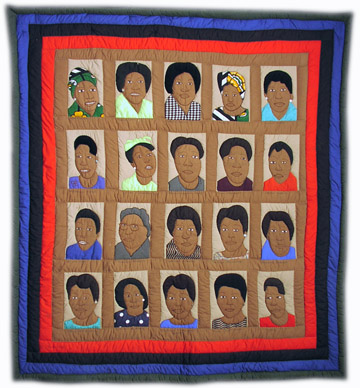
South African Black Women Anti Apartheid Leaders
Fina Nkosi
Soweto, South Africa
2000
Collection of the Michigan State University Museum acc.#2004:134.1
The quilt incorporates portraits of black South African women who the artist felt were instrumental in the struggle for freedom in South Africa. Depicted, left to right and with artist's original spelling in parentheses, are: (row one) Winnie Mandela, Albertina Sisulu, Adelaide Tambo (Addelatte Thamo), Lindiwe [no last name give, but likely Lindiwe Nonceba Sisulu], Thandi Modise; (row two) Nokukhauya Huthuli, Lillian Masediba Ngoyi (Lillian Mosediba Ngoyi), Princess Constance Magogo (Princess Contance Magogo), Dudu Masondo, Stella Sigcau (Stell Sigcawu); (row three) Dipuwo Hanni, Florence Mkhize (Florance Mkmize) Charlotte Maxeke, Dr. Ellen Khuzwayo, Princess Irene (Princess Irene); and (row four) Marry [sic] Nontolwane, Lillian Ntshang, Felicia Mabuza-Suttle, Rose Givamanda, and Kate [no last name given, but likely Kate Molale].
The quilt was included in a national exhibition of crafts shown at the Craft Council of South, Johannesburg, South Africa, 2004. It was acquired by the Michigan State University Museum during a bi-national South African Cultural Heritage Project for which the MSU Museum was a lead US partner.

Floral Appliquéd Medallion
Rosa Louise Parks
Detroit, Michigan
1939-1949
Collection of the Rosa Parks Estate
Mrs. Parks, one of the world’s iconic figures of civil rights activism, was by trade a seamstress. It is not surprising then that she was also a quiltmaker who first learned her quiltmaking skills from her mother while growing up in the South. Mrs. Parks registered this quilt and one made by her mother in the Michigan Quilt Project inventory, a statewide quilt documentation project coordinated by the Michigan State University Museum. This quilt design was called Heritage in a 1942 Lee Wards catalog.
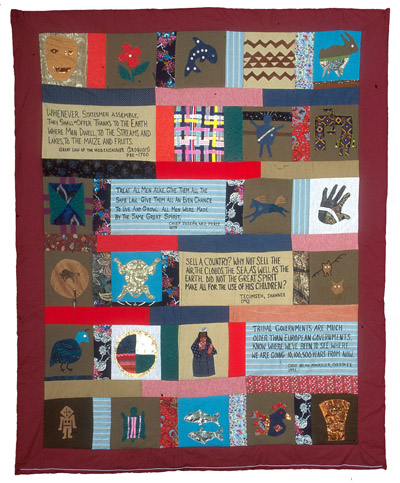
Honor the First Nations
Pat Courtney Gold
Scappoose, Oregon
1996
Collection of the Michigan State University Museum acc.#1996:124.2
Wasco artist Gold, a recipient of the National Endowment for the Arts’ 2007 National Heritage Fellowship Award, says of this quilt, “I wanted to do a quilt to represent various tribal entities throughout the United States. I could not include all nations, and it was hard picking the art forms on this quilt. Each block represents a different tribal art and/or region. I especially wanted to show respect for the elders in a block. I chose the clothing style during transition from the 'traditional ways'' to the 'white man' ways. I felt this was a painful time in tribal history, and the strength of the generation was passed to us. I left her face undefined, so that as we look at her, we will each see our grandmothers. Another strong symbol is the turtle. I did put various herbs in it, as do many tribes. The circle of life is whole. I varied it by putting a golden halo around it. It displays the reverence as do the halos around the Christian figures."
The quilt includes: wood mask (Iroquois); beaded flower (Plateau); whale (Alaska); basket design (Plateau); rabbit (Southwest); quote (Iroquois); weaving modern twill; petroglyph (Southwest); Yei figure (Navajo); cornhusk (Nez Perce); quote (Nez Perce), horse (Plains); hand (U.S.); drum (Plains); frog (Northwest); quote (Shawnee); petroglyph (Wasco); quail (Southwest); circle of Life-(U.S.); elder (U.S.); quote (Cherokee); basket figure (Wasco); turtle (Midwest); salmon (Northwest); bird (Pueblo); and shield (Alaska).
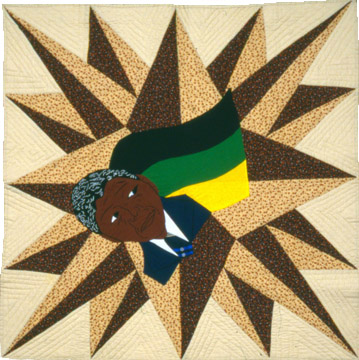
Mr. Mandela
Beverly Ann White
Pontiac, Michigan
1990
Collection of the Michigan State University Museum acc.#2003:50.2
Of this quilt, White says: “My statement quilts are made as a result of emotion. The inspiration for Mr. Mandela came from the very strong emotions of elation and relief I experienced when he was released from his years of captivity in South Africa.” The museum has over forty African-American and African quilts, as well as quilt-related documentary materials, which reflect a wide range of individual styles and traditions found within Africa and African diasporic communities.
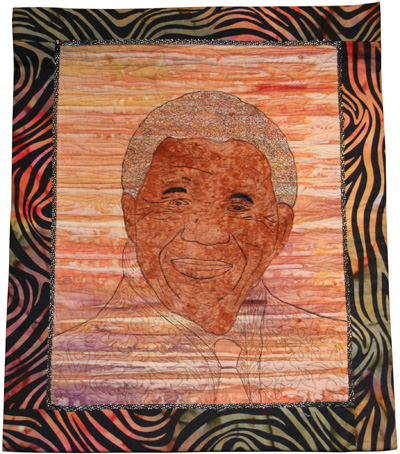
Nelson Mandela's Presence
Meena Schaldenbrand
Plymouth, Michigan
July 2004
Collection of the Michigan State University Museum acc.#2001:158.1
This quilt was made for the Michigan Quilt Artist Invitational whose theme was “Exploring Africa.” Of this quilt, the artist says, “I greatly admire Mr. Mandela and decided to draw his portrait free motion on the sewing machine.”
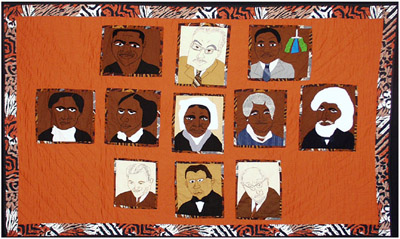
View from the Mountain Top
Beverly Ann White
Pontiac, Michigan
1991
Collection of the Michigan State University Museum acc.#2003:50.1
"I cannot chronicle the brave and valiant fight of each and everyone of the honorable souls who have fought for the rights of African-Americans throughout the history of the United States; I can, however, attempt to show several of those heroes who have impressed me. May GOD and those who are not represented here forgive me and perhaps their souls will move other African-Americans to produce more and more quilts that will extol their efforts and keep the struggle alive to ensure the ultimate goal of equality for all."
White made this quilt to teach students, family, and friends about important heroes in African-American history. The quilt features appliquéd and embroidered portraits of Medgar Evers, Thurgood Marshall, Martin Luther King, Jr., Harriet Tubman, Frances E. W. Harper, Sojourner Truth, Mary McLeod Bethune, Frederick Douglass, Ralph Bunche, Booker T. Washington, and W.E.B. Dubois.
Interview with Beverley Ann White on Martin Luther King Day, 2008 at the Quilts and Human Rights exhibit, Michigan State University Museum.
Interviewer: Marsha MacDowell.
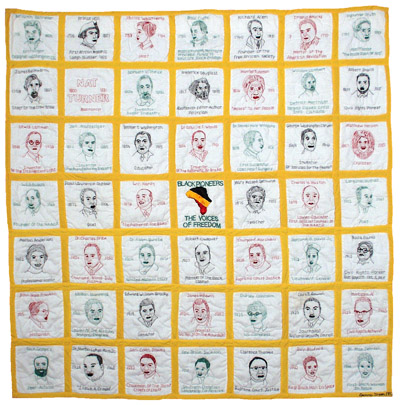
Voices of Freedom
Deonna Todd Green
Remus, Michigan
1992
Collection of the Michigan State University Museum acc.#2000:67.2
Each of the 49 blocks in this quilt is devoted to a different important figure in African-American history and includes an embroidered portrait, the person's name, their birth/death date, and a note about their accomplishment. The embroidery is in green, red, and black embroidery floss – the colors of the Pan African Flag. This flag was originally created by the members of the Universal Negro Improvement Association (UNIA) and African Communities League as the official banner of the African Race. It was formally adopted by UNIA in article 39 of the Declaration of Rights of the Negro Peoples of the World on August 13, 1920, during their convention held in New York City. The flag and the colors became an African nationalist symbol for the liberation of African people everywhere.
Interview with Deonna Todd Green on Martin Luther King Day, 2008 at the Quilts and Human Rights exhibit, Michigan State University Museum.
Interviewer: Marsha MacDowell.
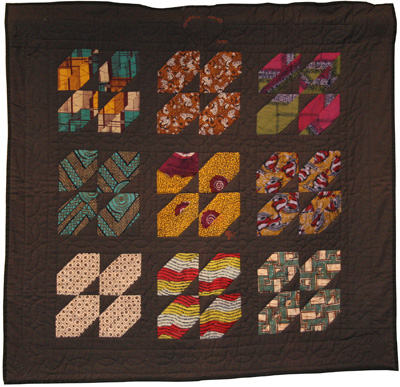
Tribute to Nelson Mandela
Hilda Freeman Vest
Detroit, Michigan
1990
Collection of the artist
“Fascinated by African fabrics since discovering the joys of quilting, I was auditioning scraps of the brillliant colors when news of Nelson Mandela's release from prison flooded the air waves. How timely, I decided, it would be to fashion the King's X pattern I had already chosen into a humble "monument" dedicated to his survival after twenty eight years as a political prisoner. African symbols were incorporated into the quilting and I proudly embroidered "MANDELA FREED 2-11-90.” Vest purchased the scraps of fabric used in this quilt from a vendor at the African World Festival. “I gave him $30 and weeks later, he must have cleaned out his studio because he sent me a box of African scraps which included pieces of garments, such as sleeves, etc.”
This quilt has appeared in exhibitions at the Museum of African History in Detroit (1995); Juneteenth Celebration in Oberlin, Ohio; Detroit Public Library (2005); Greenfield Village, Dearborn; and in 1996, took a second place ribbon at the Senior Olympics, Detroit Parks and Recreation.
Interview with Hilda Freeman Vest on Martin Luther King Day, 2008 at the Quilts and Human Rights exhibit, Michigan State University Museum.
Interviewer: Marsha MacDowell.
Quilts Document or Remember an Event or Experience
Some artists focus their textile work on a single experience or event that often has become a symbol of human rights violation and activism. Quilts have been made, for instance, to depict the imprisonment and release of Nelson Mandela in South Africa, the Mohawk incident at Oka in Quebec, the bombing of Afghanistan, and the student resistance in Tiananmen Square in China. While these document individual instances of human rights transgressions they also raise awareness of other similar transgressions.
Interview with Carolyn Warfield on Martin Luther King Day, 2008 at the Quilts and Human Rights exhibit,
Michigan State University Museum.
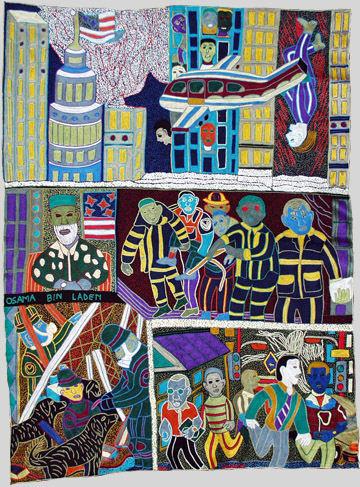
9/11
Unknown artist from the Kaross Workers
Letsitele, North Province, South Africa
2002
Collection of the Michigan State University Museum acc.#2000:58.2
In 1988, painter Irma van Rooyen organized a project to provide regular employment for wives of male workers - mostly Tsonga or Venda speakers - on the farm run by her husband. Five women participated at first and, as of 2004, the number has grown to over four hundred and now also includes a few men. This piece, one of the many representations by artists around the world of the destruction of the World Trade Center in September 2001, illustrates the worldwide access via media that artists, even in remote areas, have to war related events.
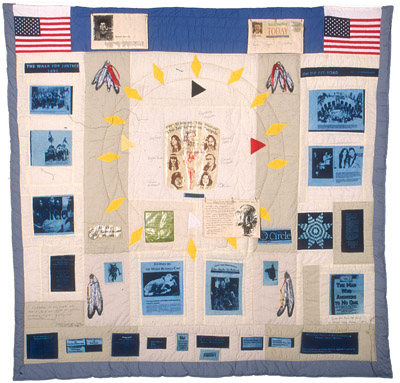
News From Native America
Judy Toppings
White Earth, Minnesota
1996
Collection of the Michigan State University Museum acc.#1996:134.1
Ojibwa/Anishnabe artist Toppings made this pictorial quilt to commemorate American Indian demonstrations, protests, community and political history. The quilt is signed in lower left corner: “Dedicated to all people who take stand and fight for justice, freedom or religion, equality and environmental issues. Judy Toppings, 1996, White Eart Rez., MN.”

So Many Twin Towers
Diana N'Diaye
Washington, D.C.
2007
Collection of the Michigan State University Museum acc.#2008:120.1
y work is inspired by traditions of visual storytelling and improvisation in the quilts created by Sea Island needle artists. My ancestors and elders are my muses, always with me in my dreams at my sewing table. This piece was created as a gut response to the bombing of Afghanistan and other inhumane and inappropriate reactions to the bombings on 9/11. These actions and subsequent invasion of Iraq, violations of the Universal Declaration of Human Rights, have added innumerable innocent deaths and ruined lives to the toll of the tragedy of the twin towers.
N'Diaye is an anthropologist, visual artist, Cultural Heritage Specialist and Curator at the Smithsonian's Center for Folklife and Cultural Heritage and a Research Associate, Michigan State University Museum. N'Diaye grew up in a Carribean family where she learned at an early age a love of needlework from her elder aunts and a love of working with cloth from her mother Patricia Croney and her teacher, New York couturier Zelda Wynn. She also counts artist and quiltmaker friend Faith Ringgold as an early mentor and influence. In the early 1980s, Dr. N'Diaye was a member of the Urban Fiber Artists. Her work was featured in the juried exhibition Folk Art-Traditions and Innovations at Harmony Hall Gallery, Fort Washington, Maryland, in 2007.
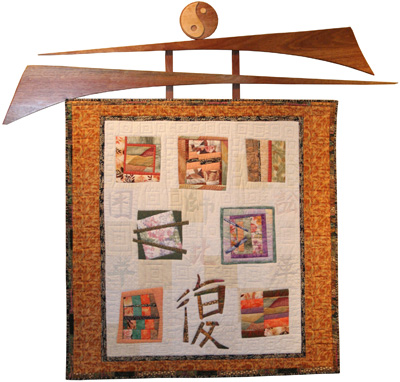
Tiananmen Squares
Kerry Nagel
Whitefish, Montana
1998
Collection of the International Quilt Study Center acc.#1998.008.002
1989 … The Communist Regime in China stands firm. My six inch background fabric blocks line up in a row … pale, squared off, void of character or color. The army stands in formation.
Spring … Students gather. Their newfound ideals and philosophies are still in formative stages. I add muted pastel pieces, free-formed and not yet fully defined, over the neatly trimmed base. Hardliners and activists share one surface.
April … Chinese ancients believed that every act has Six Stages, with the Seventh Stage being The Turning Point. And so it was at Tiananmen Square. The Chinese characters stitched into the quilt represent: K’UN – Oppression; SHIH – The Army; SUNG – Conflict; TZ’UI – Massing together; PI – Holding Together; KO – Revolution. The final character, constructed of fabric in the same stroke order as proper Chinese Calligraphy, symbolizes FU, The Turning Point. The uprising is put down, but the corner has been turned …
This quilt was honored with a second place prize in: Expressions of Freedom: Quilts Celebrating Human Rights, a contest and exhibition held by the International Quilt Center, University of Nebraska-Lincoln in 1998 to honor the 50th Anniversary of the United Nations Declaration of Human Rights.
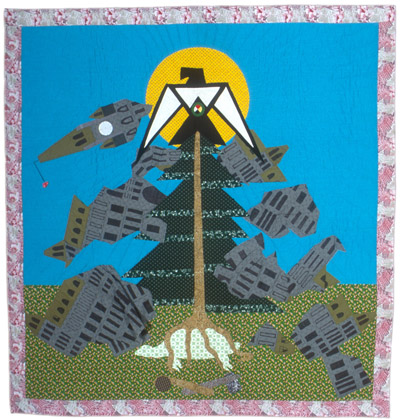
Tree of Peace Saves the Earth
Alice Olsen Williams
Curve Lake First Nation Reservation, Ontario, Canada
1991
Collection of the Michigan State University Museum acc.#7593.1
Anishnabe quilter and Trent University faculty member Alice Olsen Williams made this signed work, inspired by Mohawk teachings of the White Root of Peace, to commemorate the Oka incident in 1990 when the Mohawks resisted the further taking away of their land.
I personally want to pay tribute to and honor the Mohawk people at this time because, against great odds, they made known to the world, and brought up to date, the fact that we aboriginal peoples all over the world are still trying to regain our rights to our lands, our cultures, our relatives, our language, our beliefs and customs and our world views that we have to struggle and fight for constantly. The fight to save ourselves isn't just about what happened 100 or 200 or 300 or 400 or even 500 years ago as the dominant ideology would want us to believe; THE CIRCUMSTANCES, MACHINERY, and IDEOLOGY ARE STILL in place, are still HERE, in motion, alive and well, to get rid of us, the First Nations Inhabitants of the great and sacred Turtle Island.
In the comfort of my home, while the Mohawks were suffering inhuman insults and conditions at the hand of our enemies, I had the privilege of being able to think and wonder about how, through my art, I could be able to show my love and respect for these Mohawk people who have put their lives, their families, their loved ones on the line to stand up to that oppressive, unjust, inhumane, degrading, genocidal massive machinery. It is one thing for me to be able to have the luxury of sitting in my work area and commemorate a piece of art to honor the just and brave Mohawks and quite another to be out there on the front lines, fighting and defending our rights and laying my life on the line. I realize this contradiction and I know it is not good enough to say, "I'm sorry," and to say, "Thank you," to them.
The Mohawk teaching about the Great Tree of Peace talks about the time when there will be peace over all the Land. At the top of the tree sits the Eagle, the strong and sacred bird who helps to look after all the Beings and takes our prayers to the Creator. Around her is the Sun, a Life-giver, for without the Sun, there would be no Life. The four roots of the Sacred Tree of Peace represent the Four Directions that embody the teachings of sharing, honesty, kindness and caring. The roots are on the back of a turtle that represents Turtle Island. Under the roots are buried weapons [crossed tomahawk and war club] of oppression. When peace is allowed to come, all implements of war shall be buried. We believe that a patriarchal, capitalist, socioeconomic ideology permeates the land. This system is represented by the [Canadian] Parliament buildings. As First Nations people we believe it is the Anishinaabeg who will teach the white man about the balance of the natural world and how to live in harmony and peace with all of Creation. This is shown by the Tree of Peace growing through the Parliament buildings, destroying all that they stand for and replacing it with the teachings of peace, caring, sharing, and harmony.
Williams’s work has been published in magazines and books, shown in many exhibitions (including To Honor and Comfort: Native Quilting organized by Michigan State University Museum and the National Museum of the American Indian), and is in many private and public collections in Canada and in the U.S.

Yesterday: Civil Rights in the South III
Yvonne Wells
1989
Collection of the Montgomery Museum of Art
The story in this quilt is revealed by vignettes of different events (not in chronological order). It begins in the lower right corner: the Mayflower arrives at what is now the United States, and a black man rows a white man ashore; people picking cotton and a lynching are immediately visible to the left. Next comes Rosa Parks's historic bus; above that is a depiction of the Mississippi dam in which Michael Schwerner, James Chaney, and Andrew Goodman (the three figures to the left of the strip of brown fabric) were buried. The illustration in the upper left represents the bombing of the chuch in Birmingham that killed four little girls (at that church, one grave is set apart from the other three, so Wells shows only three graves); next is a representation of George Wallace's "stand in the schoolhouse door" to prevent the University of Alabama's being integrated; slightly to the right and below are symbols that indicate the presence of the Ku Klux Klan in the South. A dog on a long leash symbolizes Bull Connor, Birmingham's commissioner of public safety who set police dogs on civil rights marchers; the capitol building in Montgomery is shown with the Confederate flag atop the national and state flags (a situation that has been corrected since Wells made this quilt - the Confederate flag now flies on a separate staff elsewhere on the capitol grounds). The man in the middle of the bright sunshine is Martin Luther King, Jr., and he is surrounded by marchers, both black and white. One in a green garment is being hit with a water hose, another technique used in Birmingham to discourage civil rights demonstrators. Segregated water fountains are shown beneath the fireman. The red background represents the fire, the bloodshed, the tumult of the time that Wells calls "Yesterday."
[Text from exhibition catalogue Just How I Pictured It In My Mind: Contemporary African-American Quilts from the Montgomery Museum of Fine Arts, Montgomery Museum of Fine Arts and River City Publishing, Montgomery, Alabama, 2006.]
Quilts Express Collective Transgressions Against Human Rights
Artists around the world have made quilts to portray wide-scale transgressions of human rights. They have made quilts, for example, about rape, incest, domestic abuse, indigenous rights, worker’s rights in Chile, civil rights in America, the Holocaust in Europe, and Apartheid in South Africa. Some of these quilts were simply made as memorials; some were made as educational pieces specifically to raise awareness of the violations of rights and to call for assistance and action.
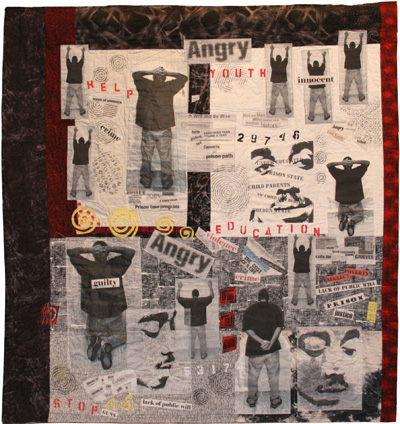
Angry Young Men
Marion Coleman
Castro Valley, California
2006
Collection of the Michigan State University Museum acc.#2008:157.1
“Angry Young Men is a fiber collage quilt that examines urban violence, the criminal justice system in the United States and community ambivalence toward the loss of a generation of young African American men. There appears to be a lack of public will to address their basic human right to have an enriched life, health, education and prosperity.”
Arpillera
Unidentified artist
Chile
c1980
Collection of John Beck and Ann Austin
MSU labor educator and MSU Museum adjunct curator John Beck acquired this work in 1981 or 1982 in Ann Arbor from Madame Letellier (the widow of Orlando Letellier who was assassinated in Washington, D.C., by the Pinochet regime) who was an instructor in the Residential College at the University of Michigan. The textile depicts a strike by the professionals’ union (professors, engineers, etc.). A small piece of paper rolled up and inserted in the back of the textile carried text in Spanish that references dismissal of 45 employees.
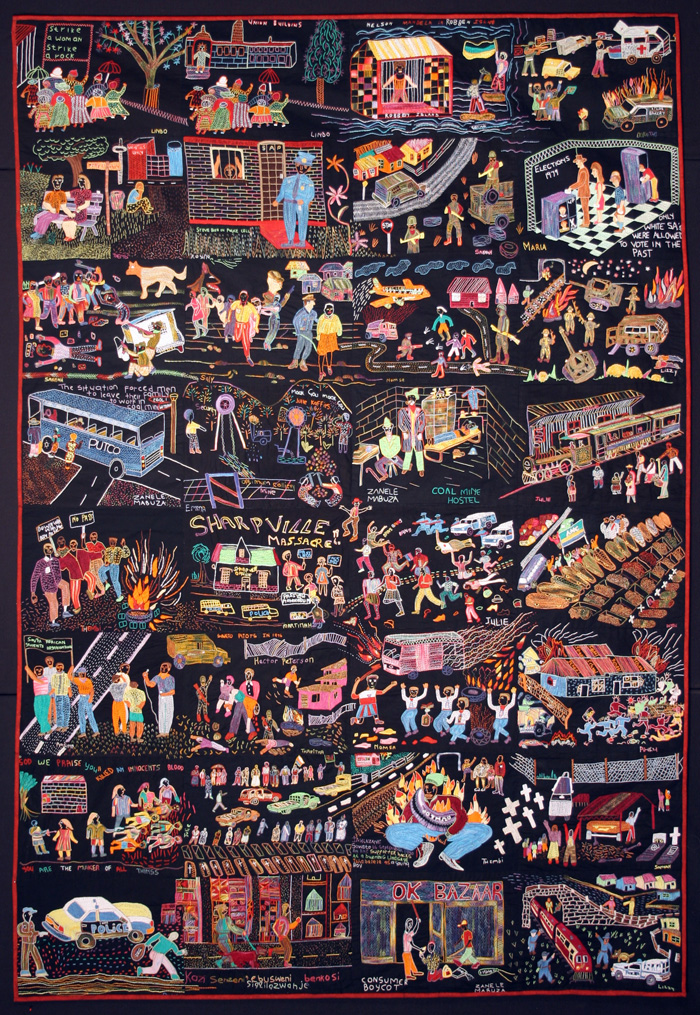
Journey to Freedom, Memory Quilt
Intuthuko Sewing Group*
South Africa
2004
Collection of UNISA (University of South Africa)
This hanging was made especially for an event at the University of South Africa that reflected on the demise of apartheid. Coordinated by UNISA faculty Gwenneth Miller and Wendy Ross, the multimedia project included the creation of two embroidered memory quilts as well as a digital animation. Each square represents one woman’s memories. The two panels include such historical events as the Sharpeville Massacre of 1960, in which the police fired on a crows of black protesters, killing 69; the student uprising and massacre in Soweto in 1968; and the first elections under the new democratic government. The figures with tires around their necks are being “necklaced” (burned to death when gasoline is poured on the tire and ignited) on the suspicion of collaborating with the authorities.
*Celia de Villiers, Sonja Barac were the professional artists who facilitated and mentored the following individual artists in the Intuthuko Sewing Group: Pinky Lubisi, Thembisile Mabizela, Zanele Mabuza, Angie Namaru, Lindo Mnguni, Julie Mokoena, Salaminha Motloung, Angelina Mucavele, Thabitha Nare, Nomsa Ndala, Maria Nkabinde, Cynthia Radebe, Sannah Sasebola, Rosinah Teffo, Lizzy Tsotetsi, Dorothy Xaba
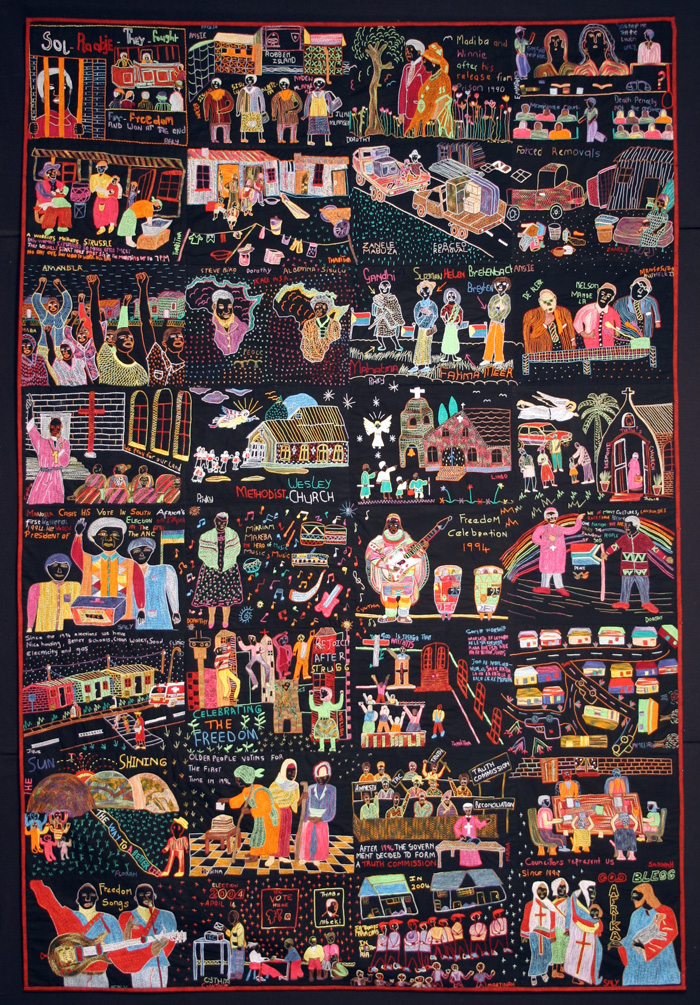
Journey to Freedom, Memory Quilt
Boitumelo Sewing Group*
South Africa
2004
Collection of UNISA (University of South Africa)
This textile was made especially for an event at the University of South Africa that reflected on the demise of apartheid. Coordinated by UNISA faculty Gwenneth Miller and Wendy Ross, the multimedia project included the creation of two embroidered memory quilts as well as a digital animation. Each square represents one woman’s memories. The two panels include such historical events as the Sharpeville Massacre of 1960, in which the police fired on a crows of black protesters, killing 69; the student uprising and massacre in Soweto in 1968; and the first elections under the new democratic government. The figures with tires around their necks are being “necklaced” (burned to death when gasoline is poured on the tire and ignited) on the suspicion of collaborating with the authorities.
*Erica Luttich was the professional artist who facilitated and mentored the following individual artists in Boitumelo Sewing Group: Flora Raseala, D. Emmah Mphahlele, Lilian Mary Mawela, Ammellah M. Makhari, Martinah P. Mashabela, Naledzani R. Matshinge, Gloria Melula, Elisa D. Mahama, Linda Mkhungo
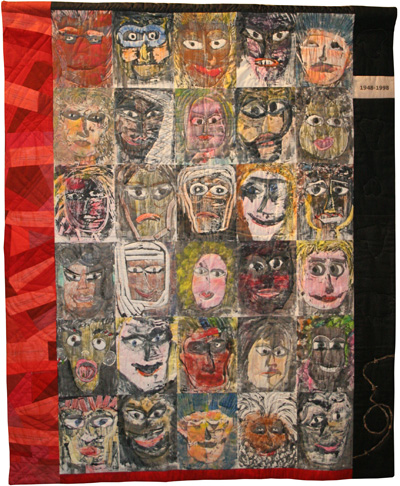
Menschen
Gisela Rikeit, et al
Graben-Neudorf, Germany
1998
Collection of the International Quilt Study Center acc.#1998.008.0001
Joy and pensiveness – this quilt shall evoke those reactions
30 faces – produced in monotype highlighted by wax –
represent peoples cultures, and religions of our world.
The bright colors demonstrate our positive
Emotions, born by the knowledge of the
Achievements in the fight for human rights
The black border, in places with barbed wire,
Expresses our sadness, knowing that torture,
Imprisonment, and atrocity are still reality In some countries
On the border to the left we have written
Selected human rights articles on a fabric
Colored red – synonymous for pain and blood
This quilt was honored with the first prize in Expressions of Freedom: Quilts Celebrating Human Rights, a contest and exhibition held by the International Quilt Study Center, University of Nebraska-Lincoln in 1998 to honor the 50th anniversary of the United Nations Declaration of Human Rights.
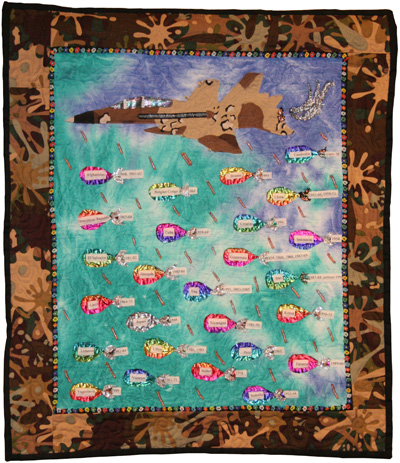
Merits of Bombs?
Meena Schaldenbrand
Plymouth, Michigan
November 2005
Collection of the artist
“Twenty-six countries have been bombed by the USA since 1945. The quilt is already outdated since it was made in 2005
and bombs are still exploding in Iraq today! Are these facts sobering enough to shock us into peace? What is the meaning of this?”
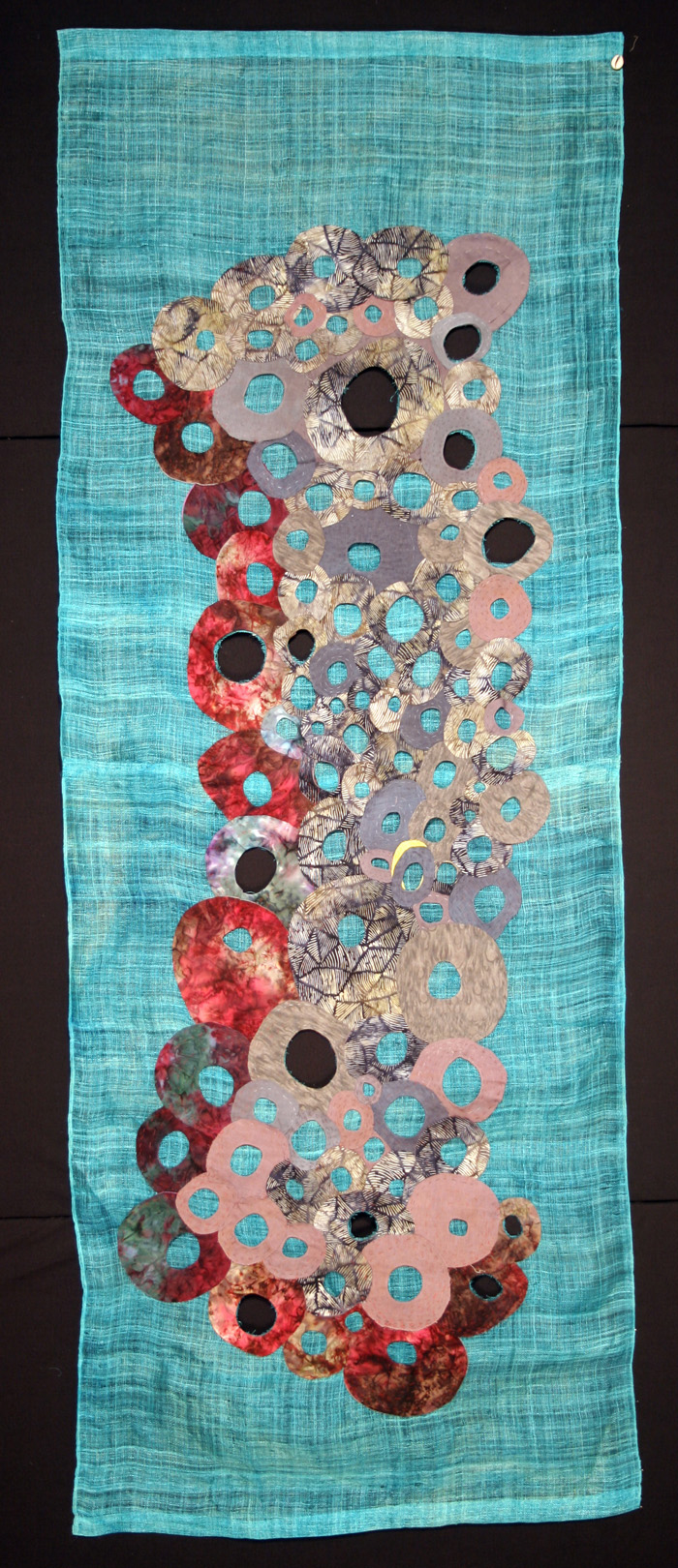
Middle Passage
Karimah Abdusamad
Durham, North Carolina
2007
Collection of the artist
“Of the many roles that an artist has in a society one of them is to call attention to the triumphs that the society revels in as well as the injustices that it has committed and upholds as part of its laws. With the 200th year anniversary of the abolition of the trade in human beings looms near it becomes increasingly apparent that the Middle Passage begs to be revisited and evaluated in order to have true reconciliation.
It is also the role of the artist to present some works in such a ways as to evaluate and allow the viewer to interact and have a relationship with the work that stimulates the intellect over the emotions and in a way encouraging said person to willingly participate in a visual dialogue. By abstracting the Middle Passage as I have done it is my hope that the viewer will engage with the piece and then with themselves, thus looking a bit longer and reflecting a lot deeper.”
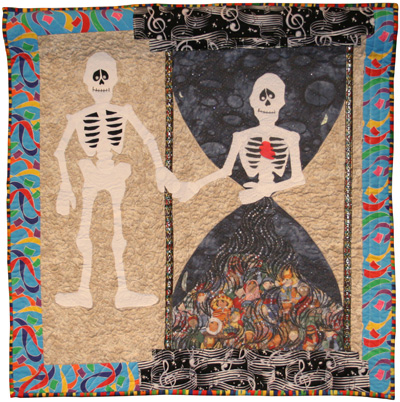
Peeling Layers Back to Basics
Meena Schadlenbrand
Plymouth, Michigan
DJuly 2000
Collection of the Michigan State University Museum acc.#2001:158.2
Underneath our many layers of clothing and skin we are the same.
Marvel at our similarities, celebrate our differences.
Have a heart, reach out, and lend a hand...
Make a difference in the short time we have...
This quilt was included in Roots of Racism, a juried international exhibition first organized in 2000 in Memphis, Tennessee. The exhibition began when quilt artist Susan Leslie Lumsden sent a plea over the Internet calling on her fellow quilters to address the global problems of prejudice and hatred. Within hours, hundreds of American quilters had responded and the concept for a group exhibition was subsequently shown at the US Ambassador's Residence in Islamabad, Pakistan as part of the 2003-2005 Art in Embassies program. The Art in Embassies Program exhibitions play an important role in our nation's public diplomacy. They provide international audiences with a sense of quality, scope, and diversity of American art and culture through the accomplishments of some of our most important citizens, our artists.
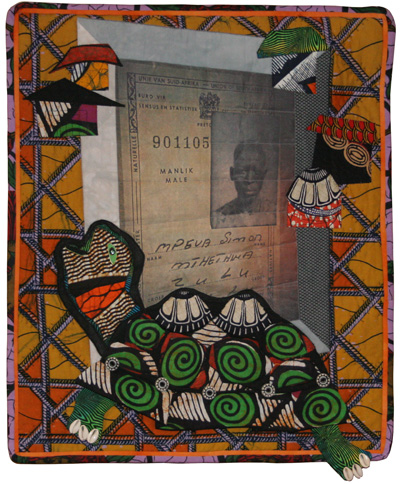
She Carries Her House
Chris Worland
East Lansing, Michigan
Spring 2000
Collection of the Michigan State University Museum acc.#2008:155.1
“In the summer of 1999, I traveled to South Africa. The South Africans I met were very welcoming and friendly. When they began to tell stories of living through apartheid, I was shocked by the level of violence and coercion and dismayed by my ignorance of that horrible period in South Africa’s history. This quilt is my response to that trip. The pass book photo is from a museum in Durban, Kwa Muthle Museum. The turtle was inspired by a woodcut by Carina Minnar. The turtle represents the rights granted in the 13th clause in the South African Bill of Rights. Like the turtle who carries her house with her, South Africans are now free to reside where they please.”
Under apartheid, all non-white South Africans were subjected to strict rules of segregation and limits of their rights. All non-whites had to carry a pass book which included their photograph and a statement of whether they were Indian, black, or colored (mixed race). Failure to produce a pass book on demand often led to harassment, torture, and imprisonment. The system of pass laws was finally repealed in South Africa in 1986.
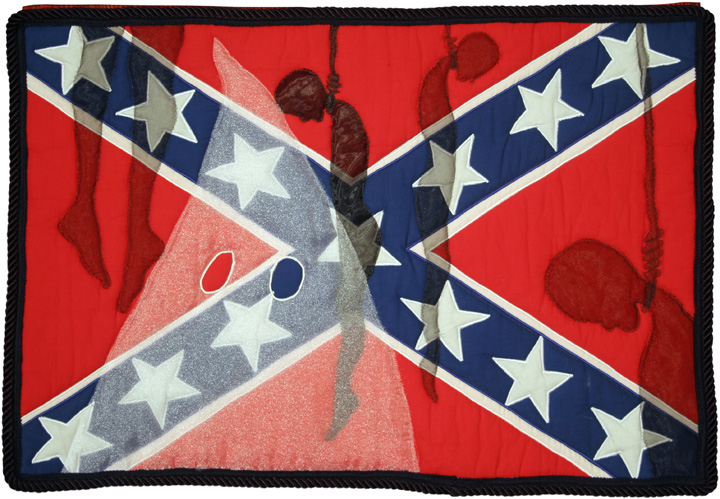
Southern Heritage, Southern Shame
Gwendolyn Magee
Jackson, Mississippi
2001
Collection of the Michigan State University Museum acc.#2008:159.1
“This quilt is my response to the failure of the April 17, 2001 referendum for the State of Mississippi to adopt a flag without the confederate battle emblem. Proponents to retain it stated that it is just a symbol of southern pride and southern heritage. My goal with this piece is to expose exactly that of which they are so proud - a heritage that glorifies slavery; a heritage based on racism and hatred; a heritage that committed atrocities and unspeakable acts of savagery; and a heritage dedicated to oppression by using terroristic tactics to instill fear and impose subservience.”
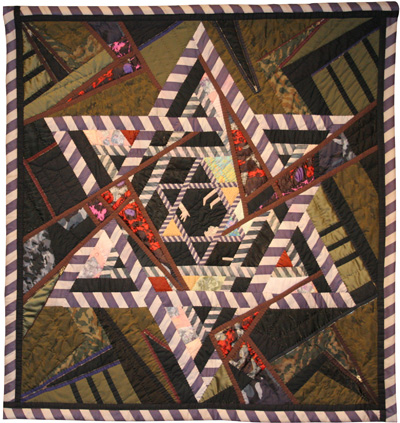
The Holocaust
Natalia Merentseva
St. Petersburg, Russia
1998
Collection of the International Quilt Study Center acc.#1998.008.0008
“I could give my work this subtitle: People Violate Human Rights. An opinion exists that the war crime can be explained by the cruelty of the wartime. We cannot agree with it. No one is born to be a criminal. Human extermination on a mass scale is the last link in a long chain where a small crime gives rise to a bigger one. That is why there are not more important or less important paragraphs in the Declaration of Human Rights. Even a simple nonobservance of political correctness in a statement today can be a reason of genocide against the whole nation tomorrow.”
This quilt was honored with the Former Soviet Union Regional Prize in Expressions of Freedom: Quilts Celebrating Human Rights, a contest held by the International Quilt Center, University of Nebraska-Lincoln in 1998 to honor the 50th anniversary of the United Nation’s Declaration of Human Rights.
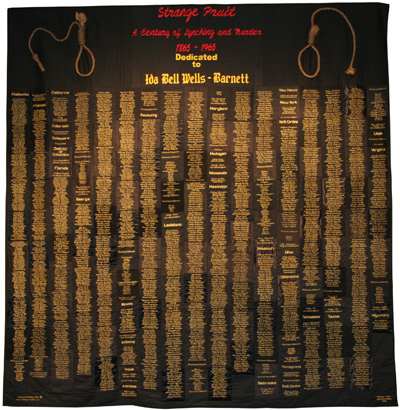
Strange Fruit: A Century of Lynching from 1865-1965
April Shipp
Auburn Hills, Michigan
2003
Collection of the artist
“Strange Fruit is named after a song by the late Billie Holiday, and it’s dedicated to Ida Bell Wells-Barnett, an African American Newspaper journalist born in 1862, who fought for an anti-lynching law. The story of my Quilt began with an episode of the Oprah show. Her guest had written a book entitled The Face of Our Past, a book dedicated to African American Women. The book was filled with marvelous photos, but one picture was not so marvelous. It was a post card of a mother and her son who had been lynched side by side from a bridge. Until that moment, it never occurred to me that they lynched women, also. Photos were often taken of people who had been lynched. These pictures were called post cards because that was what they were. I have a son who at the time was only five. I thought, if an angry mob came after my boy what would I do? Who do you turn to for help when the whole town is coming after your child? I began to pray, "Father God, someone needs to do something about this." These people need to be known, if not their stories, at least their names. I believe the spirit of the Lord spoke to me, "Find their names and make a quilt."
“Strange Fruit weighs 12 pounds and its 10' long by 10'6" wide. The fabrics are various shades of black. In making this Quilt, I learned that it didn’t matter who you were. It didn’t matter how old you were. It could happen to anyone, anywhere, and anytime. I did this Quilt in loving memory of my people, people I have never met, people whose names are not only woven into the fabric of this Quilt, but also into the fabric of my heart.”
Interview with April Shipp on Martin Luther King Day, 2008 at the Quilts and Human Rights exhibit, Michigan State University Museum.
Interviewer: Marsha MacDowell.
Quilts of Memorial
Quilts are made as memorials to those who died as a result of human rights violations. Sometimes they are made in remembrance of one individual; other times they are made in remembrance of scores of individuals who died. Quilts may contain visual symbols or portraits or simply list names of those who died. Quilts have been made, for example, to depict victims of lynchings in America, ethnic genocide in Rwanda, the war in Iraq, and ethnic wars in Srebrenica.
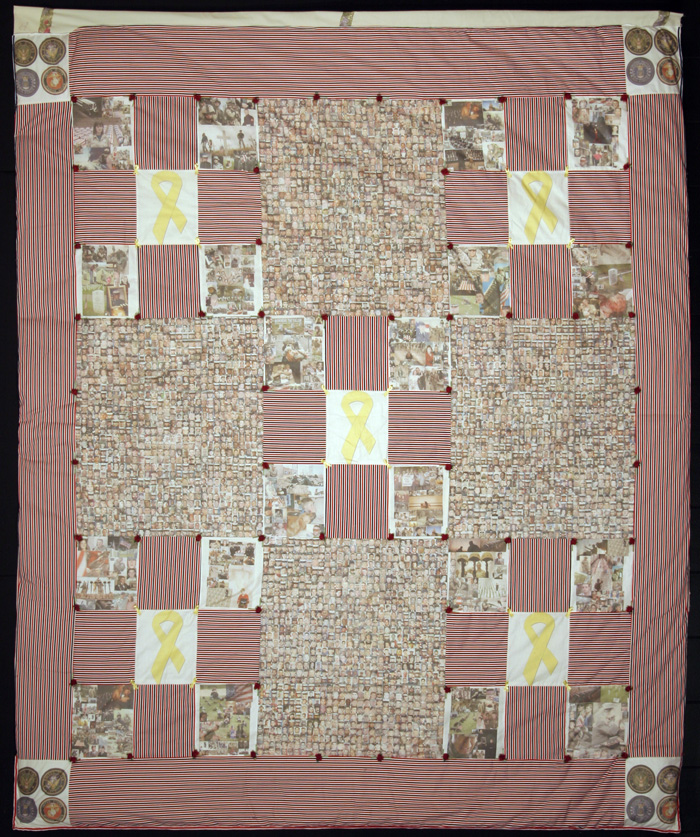
Iraq War Memorial Quilt
Cynthia Catlett
Houston, Texas
2007
Collection of the artist
“This quilt was made to recognize the faces of 3600 men and women of the military who have died in line of service in Iraq and Afghanistan since GW Bush ordered troops into Iraq in March 2003. It is the first pictorial memorial in U.S. history to honor the fallen heroes of a military conflict. These are the faces of those who have served this country, those who have died for this country and the loved ones they left behind. IT CAN NO LONGER BE ENOUGH TO SAY SUPPORT OUR TROOPS! TODAY WE MUST SAVE OUR TROOPS!”
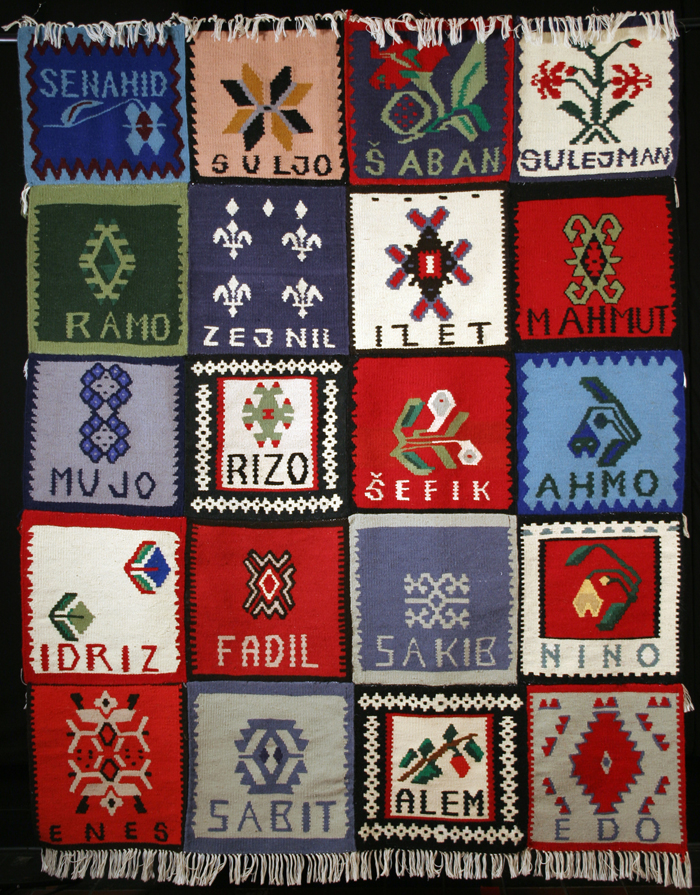
Srebrenica Memorial Quilt
Women of BOSFAM
Bosnia
2007
Collection of the Advocacy Project
Each year, on July 11, Bosnians gather at Potocari, in Eastern Bosnia, to commemorate the 1995 Srebrenica massacre, which claimed the lives of more than 8,000 men and boys. They also attend the reburial of victims whose bodies were identified in the previous year. In 2007, the women of BOSFAM, the Bosnian women's group, began this Srebrenica Memorial Quilt, in commemoration of those who were killed. The quilt was unveiled at a memorial event on July 8, 2007 in St. Louis, home of the largest Bosnian population in the United States. The quilt currently contains 20 panels, each commemorating a victim and all hand woven by BOSFAM women who lost relatives to the massacre.
BOSFAM hopes to quadruple the size of the quilt by July 11, 2008. They hope that others who lost relatives in the massacre will commission panels, and that the quilt will help them to connect to others who also suffered. The weavers hope that as the quilt grows in size it will keep the memory of the massacre alive, in community after community, and encourage local debate and media coverage about the destructiveness of the 1992-1995 Bosnian war, and the resilience of survivors.
For information about how to commission a panel, go to https://www.advocacynet.org/39189-2/. All money raised will cover the cost of weaving. BOSFAM supports women from all ethnic groups who were affected by the war in Eastern Bosnia.
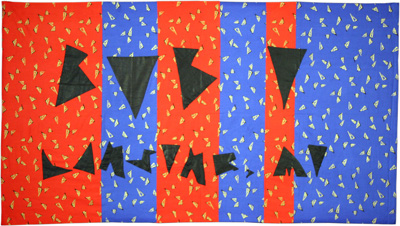
NAMES Panel
Lynne Swanson and Chris Carmichael
East Lansing, Michigan
November 1995
Collection of the Michigan State University Museum acc.#1996:52.1
The NAME Project AIDS Memorials quilt began in June of 1987, when a small group of strangers gathered in a San Francisco storefront to document the lives they feared history would neglect. Their goal was to create a memorial for those who had died of AIDS and to thereby help people understand the devastating impact of the disease. Today the Quilt is a powerful visual reminder of the AIDS pandemic. More than 46,000 individual 3-by-6-foot memorial panels – commemorating the lives of over 91,000 people who have died of AIDS – have been sewn together by friends, lovers, and family members. Laid end to end, the panels would stretch for 52.5 miles. The NAMES Project Quilt is too large to be exhibited in one spot anymore. Portions of it tour the country and are placed on view in community displays. To date, the Quilt has been visited by over 15,000,000 people. This panel was made at a NAMES Project Quilting Bee hosted by MSU Museum and the Lansing Area AIDS Network. Members of the community came together to create panels for loved ones lost to AIDS. In some cases, panels were made to honor people who had no family, or who had been estranged from their family due to their circumstances. This was the case with Bob I. Two 6’ by 3’ panels were made for him. One was sent to the NAMES Project to become part of the massive AIDS Memorial Quilt. The other panel was accessioned into the Michigan State University Museum Great Lakes Quilt Center collections in order to document and preserve an example of quilting used in public memorials and social action. For more information on the NAMES Project AIDS Memorial quilt, go to https://aidsmemorial.org/theaidsquilt-learnmore/.
Quiltmaking as a Means of Coping with Oppression and Its Memories
For many individuals, quiltmaking has served as an important mechanism to cope with oppressive experiences. Barbara Hogan, for instance, was held for years as a political prisoner in South Africa during apartheid. Now a member of the South African parliament, she says “I think I would have gone crazy all those years in prison if we did not have our quilting.” Some individuals make quilts that show their memories or feelings about personal experiences with human rights violations; this activity often helps them to work through and heal emotional scars and to record and tell their stories to others.
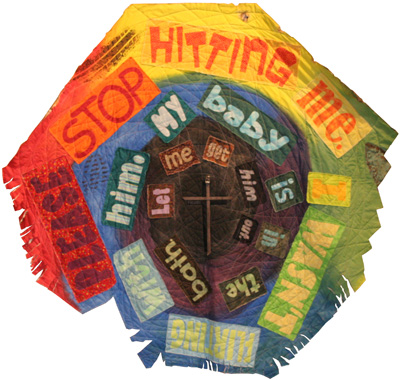
After the Party
Helen Pedersen and Janice Dowdeswell
Wanganui 4501, New Zealand
2007
Collection of the artist
The quilt refers to mathematics teacher Pedersen’s own personal story of escape from domestic violence. She said, “It has not been easy for me to reveal this, but making the quilt allowed me to close a chapter.”
Dowdeswell explains more: “The title refers to the fact that alcohol fuels a lot of domestic violence. The time immediately after, or before, social occasions is often the catalyst. The warm spectrum colors on the outer part of the quilt portray the bright exterior victims often show the world when everything on the inside is dark. The spiral background shows the feeling of being sucked down into a black pit of despair. Reducing the size of the words as we read the story depicts the shrinking of one's spirit and the feeling of smallness and insignificance. The cross shape, for others, may represent the death of a family member of the death of the relationship; for Helen it is the death that could have occurred (but, thankfully, didn't). The cross itself and the edge treatments illustrate some of the methods of physical abuse that are used. The first three words of the story hint at a solution: "Please Stop Hitting".”
The quilt was one of two top prize winners in a juried exhibition held at New Zealand’s National Quilt Symposium in Palmerston North, New Zealand, under a thematic category sponsored by the New Zealand Human Rights Commission in which entrants were asked to consider human rights abuses, their effects, and possible healing. The quilt was subsequently included in the Contest May Offend exhibition, organized by the Human Rights Commission and the School of Education at University of Waikato, New Zealand.
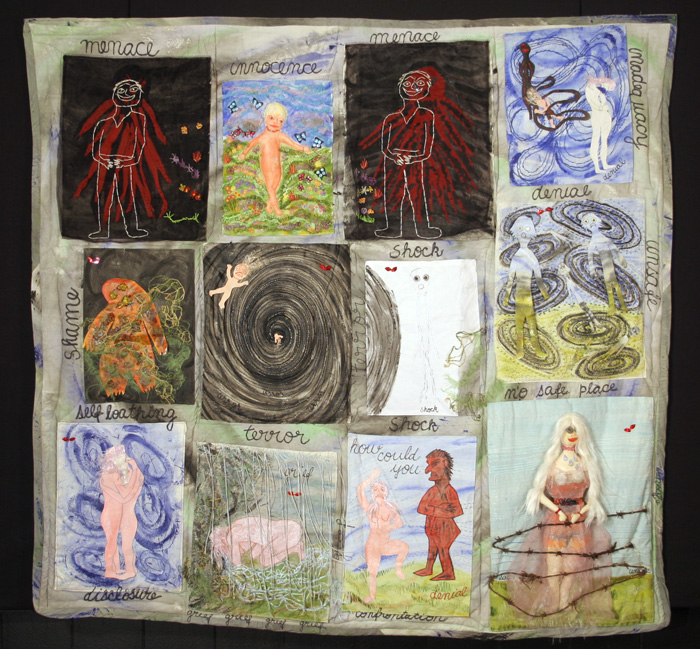
Incest
Cecily Gordon, Margaret Perowne, Megan Cooper, and Kay Lamport
2009
Collection of the artist
This quilt was one of two top prize winners in a juried exhibition held in 2007 at New Zealand’s National Quilt Symposium in Palmerston North, New Zealand, under a thematic category sponsored by the New Zealand Human Rights Commission in which entrants were asked to consider human rights abuses, their effects, and possible healing. The quilt was subsequently included in the Content May Offend exhibition, organized by the Human Rights Commission and the School of Education at University of Waikato, New Zealand. As Human Rights Commissioner Rosslyn Noonan says, “the winners truly bring home how a traditional domestic art can become a powerful medium for the important message that to be free from violence is a human right we should all cherish.” Cecily Gordon, a psychotherapist and one of the makers of this quilt, provided this statement on a separate cloth: “This quilt is for the hundreds of children and women who have told their stories. It’s about bringing these stories home to Palmerston North [a town she lived in for 20 years] where they began.”
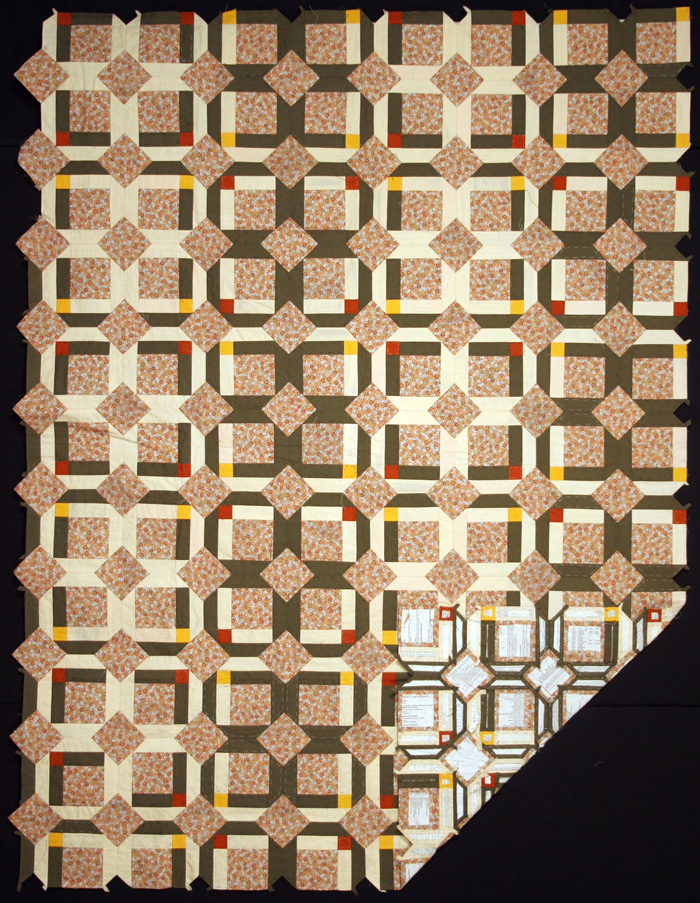
Prison Quilt
Barbara Hogan
South Africa
1990
Collection of the artist
In 1982 Barbara Hogan, a thirty-year-old post-graduate student working part-time for the Environmental Development Agency in South Africa and an ardent member of the African National Congress (ANC), the anti-apartheid political party. That year, she was detained for sending labor related material out of the country on behalf of the ANC and, after being interrogated, ill-treated and held in solitary confinement for one year she was charged with treason, Hogan admitted ‘furthering the aims of a banned organization’ but denied the charge of treason. The judge, however, found her guilty of high treason and sentenced Hogan to ten years in jail; Hogan was the first white woman to be tried for treason under apartheid and the first individual in South Africa to be tried for treason in a case that didn’t involve violence against the State. She served seven years of her sentence and was released from prison in 1990 only when the South African government lifted the ban on involvement in the ANC.
After her first year of solitary confinement during which she was only allowed a Bible and a book of poetry, Hogan was allowed to take a correspondence study course from UNISA (University of South Africa), to read other books, and to take up a craft. She taught herself how to quilt in the English pieced paper method, using torn out pages from her correspondence study books for the backing of the pieced blocks. Her warders chose and delivered fabric to her. She was still working on this quilt when, in 1990, the South African government lifted the ban on involvement in the ANC and she was unexpectedly released from prison. Now a member of the South African parliament, she says, “I think I would have gone crazy all those years in prison if I did not have my quilting.”
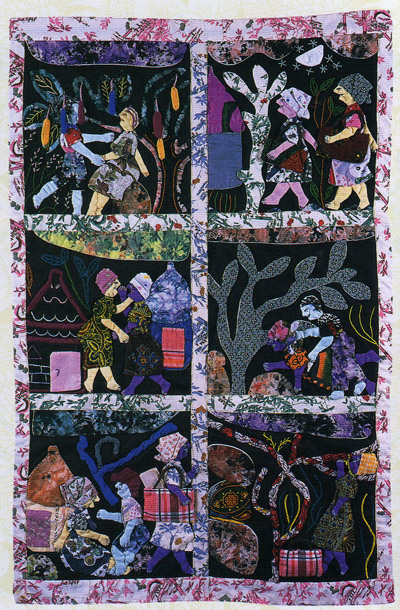
Weya Cloth
Robert Magurambe
2000
Collection of the Michigan State University Museum acc.#2000:30.1
Weya Cloths are a distinctive style of appliquéd pictorial textiles done by primarily Shona-speaking women in Weya, an impoverished rural area of Zimbabwe located about 170km east of the country’s capital, Harare. In 1987, art teacher Ilsa Noy was asked by the German Volunteer Service to devise an economic development project to assist women in becoming financially self-sufficient. Noy thought the women, already skilled in needlework, could make narrative, pictorial scenes that could be sold to tourists. The Weya textile project began with nine women; today cloths are produced by hundreds and sold by artists who travel to marketplaces and through galleries and traders around the world. This appliqué was acquired in Harare.
Artists chose stories or themes that reflect their experiences, beliefs, and attitudes. This piece tells the sad story of a woman (possibly Sarai Mugare) who hung herself after her husband beat her and left her for a second wife. A small piece of paper in the pocket of one of the panels provides more details description: 1) John was married but he fall for a girl", "2) The girl was pregnant and she eloped, with auntie's company", "3) When the wifes were staying, one day they fought for their husband (shanje)", "John loved the young wife most so he hit the older wife", "5) One day when John and his young wife were resting behind the hut, the older wife thought of running away", "6) On her way she turn to hear her life, then in the thick forest she commited suicide, with the word [Sarai Mugare].
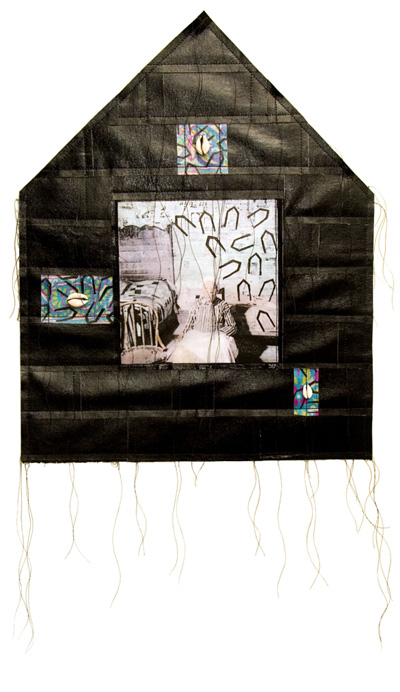
Walls Talking: Mulatto Ex-Slave in Her House Near Greensboro, Alabama
Keisha Roberts
San Francisco, California
2006
Collection of the Michigan State University Museum acc.#2008:160.1
Born into a social system that deemed her and millions like her chattel, the nameless, formerly enslaved woman in the central image of this quilt endured what seems unendurable. If her walls could talk, perhaps they would tell us how she fought to outlive a system that owned her life, then struggled through the dark years that followed to build a home and a future.
Quilts of Action
Sometimes quilts and quiltmaking are the cornerstones of projects designed to raise awareness and to directly address human rights issues. Some are single quilts made by single makers. Others are the results of projects engaging thousands in activism. For instance, the NAMES Project raises awareness of AIDS and the Ugly Quilt Project addresses the needs of the homeless in a tangible way.
More than twenty thousand individuals--most of them women—were involved in the creation of a fifteen-mile-long sewn-together series of panels, named the Peace Ribbon. It was wrapped around the Pentagon on August 4,1985, forty years after the United States used the atomic bomb against Japan as a call to stop the use of nuclear arms around the world.
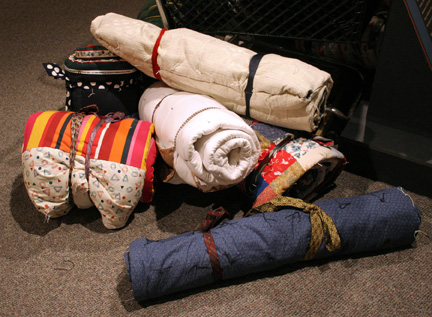
Ugly Quilt Sleeping Bag
Flo Wheatley
Hop Bottom, Pennsylvania
Started in 1985
Collection of the My Brothers Keeper Quilt Group
Our mission statement.
My Brothers Keeper Quilt Group is not a club. We are individuals and groups desiring to help the homeless by making simple sleeping bags from recycled fabrics and distributing them FREE to people who are cold on the street.
OUR ONLY PURPOSE IS TO HELP THE HOMELESS BE WARM UNTILL THEY CAN BE HELPED OR HEALED BY OTHERS IN OUR SOCIETY. CAN YOU HELP ?
Flo Wheatley held her young son, Leonard, as he was vomiting and near collapse. Returning from the hospital and his daily cancer treatments, they were a block from a subway station in New York City. It began to rain. Commuters rushed past them. Flo heard a voice say: "You need help, lady," and she looked up to see a homeless man, wearing jeans, sneakers and a cutoff army jacket. She felt a little fear and declined his help, saying: "No, we’re okay." But the homeless man said again: "You need help, lady." He picked up her suitcase and walked toward the subway. Flo and Leonard followed him and the three of them boarded the train. They all got off at Flo’s station and the homeless man hailed a taxi for her.
"I pressed a $5 bill into the man’s hand before the cab pulled away," Flo said, "and I heard him say, softly: ‘Don’t abandon me.’" Flo has never forgotten his words.
Two years later, in 1985, Leonard, who had suffered from non-Hodgkin’s lymphoma, was recovering miraculously. And in the small town of Hop Bottom, Pennsylvania (population 385), Flo Wheatley stitched her first sleeping bag, using her kids’ outgrown clothing — jeans, shirts and sweaters. She and her husband drove into Manhattan and gave the bag to a man huddled in a doorway. She made eight bags that year.
Ugly Quilts
News of her sleeping bags spread through the rural area and soon neighbors were dropping off fabrics at her home. A local church invited Flo to speak and to demonstrate how to make the bags. She named the family project My Brother’s Keeper Quilt Group. She called the bags 'Ugly Quilts' so that volunteers wouldn’t think they were too difficult to make. The grass roots project continued to grow — women began gathering to sew and socialize. Many of the sleeping bags were delivered to Flo’s garage for distribution — her garage door remained unlocked to accept deliveries. In 1992, more than 5,300 'Ugly Quilts' were distributed to homeless people and to shelters in Manhattan and other large cities.
The Wheatley family created a single page of simple instructions on how to make an 'Ugly Quilt'. The first step is to sew pieces of fabric together to form a seven foot square, and then another one. These squares are joined together. Old drapes, blankets and mattress pads are added for padding and men’s neckties are used as handles. All the fabrics are recycled. There is a big demand for these instructions.
A mail crew arrives at Flo’s home every Wednesday morning for breakfast and to open the mail bags. There are requests for instructions from all over the United States as well as other parts of the world. A missionary in Mexico asked for instructions to make a bag for himself and to teach others to make sleeping bags. There was news from American volunteers at an army camp in Germany: supply planes had dropped 'Flo-designed' sleeping bags to the refugees in Bosnia.
In Mesa, Arizona, they have just completed 2,000 sleeping bags. In Fort Ogden, Florida, they have made one bag every week for five years. Flo believes that more than 100,000 sleeping bags have been made since 1985.
Eleanor Dugan and Becky Gordon co-founded the San Francisco group. By avocation, they are both quilters. They have gained national recognition exhibiting their quilts in regional shows. But today, they are committed to making sleeping bags. Becky said: "It’s simple. If you can tie a shoe lace, you can help make a sleeping bag. And a sleeping bag can save the life of a homeless person."
The informal group meets in Eleanor’s home, which looks like a warehouse. Hilton Hotels recently donated 200 bedspreads and mattress pads, filling her living room almost to the ceiling. Her dining room contains a large cutting table and a sewing machine. And there’s a sewing machine in the kitchen. "It is not Martha Stewart living*," said Eleanor, "but these bags are literally the difference between life and death to some of the homeless." Eleanor speaks and gives demonstrations at churches, schools, clubs, organizations, and the San Francisco County jail.
At a recent Bronx Community Center demonstration, Flo was expecting volunteers to come and make bags and distribute them to the homeless. But homeless families arrived on the scene, including children. They spent the day making bags. When they left, they took the bags and slept in them that night.
Benjamin Creme has confirmed that the homeless man who came to Flo’s aid near the New York subway station in 1983 was the Master Jesus. When Flo heard this, she responded: "I believe it! The basis of my life is in Christ. Our work does not belong to any particular denomination. It is open to everyone. We appeal to people who understand the suffering of other people and have the ability to reach out."
* Martha Stewart is a popular proponent of gracious living, American style.
From the May 1997 issue of Share International
From: http://www.share-international.org/ARCHIVES/social-justice/sj_jssleepingbags.htm
The Look of Human Rights Quilts
There is no one visual or technical style of quilts related to human rights. Often, though, they are filled with symbolic and literal depictions of experiences, beliefs, and statements and are intended as visual messages rather than bed covers. Some quilts, however, give very little, if any, visual clues that they are connected to human rights; it is in their stories of why they were made and how they were used that we learn of their deep connections to human rights.
Credits
The exhibition and related programming was supported by the Michigan Traditional Arts Partnership grant from Michigan Council for Arts and Cultural Affairs and a Creating Inclusive Excellence Funding award from the MSU Office of Inclusion and Intercultural Initiatives. Supplemental funds were provided by the Michigan Quilt Project Endowment, the Great Lakes Traditions Endowment, the Department of Art and Art History, Department of Anthropology, Public Humanities Collaborative, and the Center for Gender in Global Context at MSU. In-kind support was contributed by the Michigan State University Museum.
Exhibition Curators and Project Managers: Dr. Marsha MacDowell, Lynne Swanson, and Mary Worrall
Exhibit Graphic Designer: Melinda Hamilton
Exhibition Installation Designers: Juan Alvarez, Lynne Swanson, and Mary Worrall
Object and Installation Photography: Pearl Yee Wong and Pat Power
Collection Management: Lynne Swanson, Beth Donaldson, and Mary Worrall
Installation Assistance: Mike Smola, Michelle Allard, Jamie Christian Kulhanek, Mary Blakely, Lori Hagadorn, Alicia Kildau, and El Hammock.
Educational Programs: Lynne Swanson, Mary Worrall, Marsha MacDowell, Amanda Grace Tigner, Chris Worland, and Judy Smyth
Communications Management: Lora Helou and Julia Meade
Museum Director: Dr. C. Kurt Dewhurst
Special thanks to the following: Elaine Steele, Anita Peek, Rosa and Raymond Parks Institute for Self Development, Paulette Granberry-Russell, John Beck and Ann Austin, April Shipp, Karimah Abdusamad, Cynthia Catlett, Marion Coleman, Cecily Gordon, Gwendolyn Magee, Diana N’Diaye, Keisha Roberts, Meena Schaldenbrand, Hilda Vest, Flo Wheatley, Chris Worland, Helen Pedersen, The Advocacy Project, BOSFAM, Montgomery Museum of Art, International Quilt Study Center at the University of Nebraska-Lincoln.
-
Documentation Project
Quilts and Human Rights Michigan State University
-
Museum
Michigan State University Museum Michigan Quilt Project
-
Documentation Project
South Africa Quilt History Project Michigan State University
-
Documentation Project
Michigan Quilt Project Michigan State University
-
Ephemera
Womenfolk 22. African American Quilts:...
Breneman, Judy Anne
-
2000-2025
Anti-Apartheid Po... Nkosi, Fina
-
1949
Appliqued Floral ... Parks, Rosa
-
1996
Honor the First N... Gold, Pat Courtney
-
end of February 199...
Mr. Mandela White, Beverly Ann
-
July 2004
Nelson Mandela's ... Schaldenbrand, Meen...
-
1990
Tribute to Nelson... Vest, Hilda Freeman...
-
August 1993
View from the Mou... White, Beverly Ann
-
1992
Voices of Freedom... Green, Deonna
-
2002
9/11 Kaross Workers
-
1996
News From Native ... Toppings, Judy
-
2007
So Many Twin Towe... N'Diaye, Diana
-
1998
Tiananmen Squares... Kerry Nagel
-
Winter 1991
The Tree of Peace... Williams, Alice Ols...
-
1976-1999
Yesterday: Civil ... Wells, Yvonne
-
2006
Angry Young Men Coleman, Marion
-
c1980
Arpillera -
2004
Journey to Freedo... Intuthuko Sewing Gr...
-
2004
Journey to Freedo... Boitumelo Sewing Gr...
-
1976-1999
Menschen Gisela Rikeit
-
November 2005
Merits of Bombs? Schaldenbrand, Meen...
-
2007
Middle Passage Abdusamad, Karimah
-
July 2000
Peeling Layers Ba... Schaldenbrand, Meen...
-
2000
She Carries Her H... Worland, Chris
-
after 2001
Southern Heritage... Magee, Gwendolyn
-
2003
Strange Fruit: A ... Shipp, April
-
1998
The Holocaust Natalia Merentseva
-
2007
Iraq War Memorial... Catlett, Cynthia
-
2007
Srebrenica Memori... BOSFAM
-
11/1995
Bob I Carmichael, Chris; ...
-
2007
After the Party Helen Pedersen; Jan...
Load More